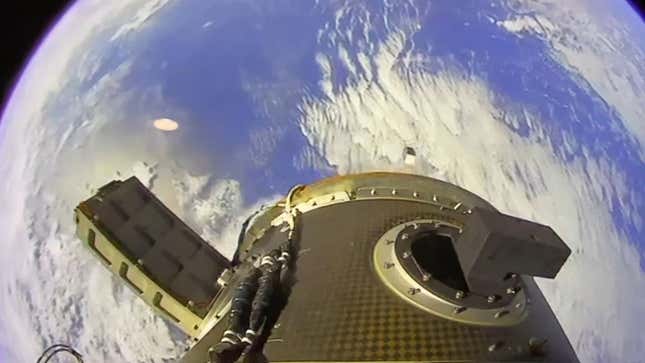
Private aerospace company Firefly declared its “To the Black” mission a success with the inaugural launch of its Alpha rocket despite the majority of the rocket’s payload having reentered through the atmosphere.
Firefly’s small satellite rocket took off on October 1 at 3:01 a.m. ET from Space Launch Complex 2 at Vandenberg Space Force Base in California. Two days later, the company announced “100% mission success” on Twitter after Alpha delivered three payloads to orbit. However, the rocket seemingly dropped off the payloads at a lower orbit than planned, causing their orbit to decay over time, SpaceNews first reported. Firefly did not immediately respond to Gizmodo’s request for comment.
Alpha rocket was carrying two small cubesats for Teachers in Space, which was designed to gather flight data for educational purposes, as well as TES-15 satellite, a collaboration between NASA and San Jose State University designed to test an “exo-brake” that can increase drag in order to de-orbit a satellite. The rocket was also carrying six picosatellites for Libre Space Foundation to test out communication and remote sensing technology.
The rocket was supposed to deliver the satellites to a 186 mile orbit (300 kilometers). Instead, tracking data from the United States Space Force initially detected the objects at an orbit of around 135 miles (220 kilometers) and apogee of 175 miles (275 kilometers), according to SpaceNews. Those lower altitudes caused the satellites’ to decay, and three of the objects reentered Earth’s atmosphere on October 5, based on the Space Force’s Space-Track database.
But the rocket company still stands behind the inaugural launch of its Alpha rocket. “Preliminary reviews show we will only require minor tweaks for our next mission, all while providing valuable scientific and technical data to our demonstration customers,” Firefly wrote on Twitter. “We’re really pleased with the data we’ve received so far.”
“Our primary objective for Alpha FLTA002 was to achieve a pre-defined elliptical orbit following the second stage burn. This was 100% successful,” the company added. But not everybody agrees, like satellite database company Seradata which declared it a “launch failure.” The company cited “the likely life loss for the seven satellites aboard when compared to their design lives,” for their decree because the satellites will reenter Earth’s atmosphere much earlier than expected, Seradata wrote on Twitter.
The 95-foot-tall (29-meter) expendable Alpha rocket is designed to provide low-cost rides for small satellites, carrying payloads up to 2,866 pounds (1,300 kilograms) for the price of $15 million per launch. With Alpha reaching orbit, Firefly became the fifth commercial rocket manufacturer in the United States to do so. Other companies include SpaceX, Virgin Orbit, Astra, and Rocket Lab.
Firefly’s first attempt to fly its Alpha rocket ended in fiery flames. On September 2, 2021, one of Alpha’s four first-stage Reaver engines shut down unexpectedly about 15 seconds after liftoff, activating the flight termination system. The rocket exploded in a massive fireball above the Pacific Ocean. So even with the loss of its payloads, Alpha’s liftoff this time around measures much better compared to the year before.
More: Firefly Sends Alpha Rocket to Orbit, One Year After Explosive Launch Attempt